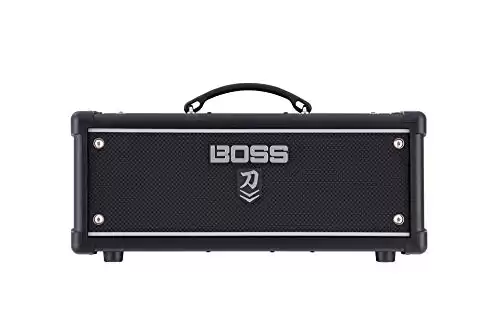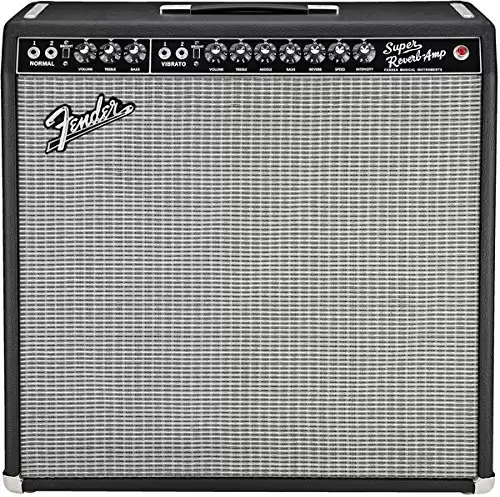There may be times when you want to practice or play an electric guitar when an appropriate amp may not be available.
Instead of giving up on the notion of having a jam session at that time, take a look around to see if any alternatives exist.
Could you hook your electric guitar into a computer to play through a DAW? Is there a portable amp that you could plug directly into your instrument? Perhaps a bass amp is available that you could use?
Can You Use a Bass Amp for a Guitar?
A bass amp works for a guitar, just as any other equipment with the appropriate cabling, pickups, and AUX would for the instrument. The issue you’ll run into with this equipment is how each note sounds since it supports more frequencies on the spectrum’s low end.
The bass guitar plays more notes on the lower end of the sound spectrum. Amps that highlight this part of the EQ push them to the forefront of what you play on your instrument, creating the vibrational goodness that comes with everything thumping line.
When you connect an electric or acoustic guitar to a bass amp, you’ll notice a meatiness to your notes that isn’t there on other speakers.
On a standard amp, you might hit the low end of the bass frequencies around the 200 Hz mark. When you use one made for the bass guitar, it may dip into the 80 Hz range.
That’s why it is a best practice to pair a bass guitar with an amp that features its strengths while doing the same for an electric guitar.
You won’t break anything by using a bass amp with an electric guitar, but you may be surprised by how your instrument sounds.
Is a Bass Amp Better than One for the Electric Guitar?
The bass guitar player’s job is to maintain the rhythm of the song. They work with the drummer to create the music’s foundation, enabling the electric guitar, keyboards, horns, strings, and other musicians to create melodies.
When Leo Fender invented the Precision Bass in 1950, a new amp was necessary to manage the instrument’s low-frequency output.
The Bassman soon followed, featuring a solo 15-inch speaker with a 50W tube.
Fender redesigned the Bassman in 1958 for better circuit support, moving to a cabinet with four 10-inch speakers instead of only one.
This idea became the gold standard for the industry, and it is still used today for those who prefer traditional sonics with their instrument.
A bass amp isn’t necessarily better than an electric guitar amp, or vice-versa. The differences between them are the speaker size, drivers, and power.
Electric guitar amps aren’t built to manage the full dynamics of a bass guitar. That’s why you can blow out your equipment by plugging a bass into an amp meant for an electric guitar.
Since the bass amp is meant to manage more power with broad, low frequencies, you don’t have the same risks to cope with when using an electric guitar.
That’s why you can use a bass amp for a guitar.
How to Set a Bass Amp to Sound Better with a Guitar
You’ll need to make some adjustments on the bass amp to help your electric or acoustic guitar sound reasonably good.
Since each amp is a little different, there isn’t one specific technique to use with your EQ that will transform the sound.
That’s why having full awareness of the features found on bass amps can help you make those local adjustments more effective.
Here is an overview of what you’ll need to consider.
■ Tone Controls
Most bass amps give you control over the treble, mid-range, and bass frequencies to create a controlled sound.
Some models provide options that include parametric equalization, splitting the output into more frequencies for nuanced tones. There could be a bright switch to create more clarity for your playing style.
Although the intention is to produce the perfect bass sound as you play, it is possible to adjust these controls to meet an electric guitar’s needs.
■ Gain Control
Most bass amps let you control how much overdrive occurs during the preamp stage. You may want to tone this feature down some when playing an electric or acoustic guitar.
■ Channel Controls
Most bass amps have at least two channels, labeled as the overdrive and clean.
You can set these controls to match the sound that you want while playing. The equipment may come with independent controllers for each channel to switch between different presets while playing.
If you have a tri-channel amp, you could power each channel separately to create active crossover networks that split the output into more of the electric guitar frequencies you want to hear.
■ Switchable Impedance
This option enables you to choose between a 4-ohm or 8-ohm output to match whatever speakers are connected to the amp.
Some models provide a 16-ohm provision. When you combine this feature with the XLR balanced, passive, and active inputs, you can produce an authentic sound for your electric guitar with a little tinkering.
■ Direct Output
If you have recording or mixing gear available with the bass amp, this feature may provide a pre-post EQ switch that tailors the sound to your specific needs.
Although it adds another step to the process before getting to play, your sounds can end up being more authentic.
Best Electric Guitar Amps to Use Today
When most beginners start playing the electric guitar, they typically use an entry-level amp to create the sounds they want.
Most of those amps are priced below $100. The idea is to see if you like playing the instrument before investing in something closer to a professional setup.
When you plug an electric guitar into any bass amp, the sounds it produces are similar to what you’d get from those entry-level models. The best way to make your instrument sing is to step up to one of the premier units found in the industry today.
The sound comparison between the two extremes is so far apart that your ears won’t believe what they’re hearing when listening to these amps.
1. Marshall Combo Amp
Marshall recently switched over to Celestion V-type speakers, and the change is one of the best adjustments made for guitarists.
You’ll get authentic sounds, dedicated resonance controls, and two separate master volume options to ensure everyone can hear what you intent to play.
The standard output wattage is 40W, although a power reduction option on the unit cuts that in half. The reverb works well in either setting.
The Marshall Combo Amp gives you volume and gain on each channel while offering consistency through the soft-tube emulated output. If you’re used to using a pedal with the amps from other manufacturers, you can make your life easier by upgrading to this unit.
It has a fantastic sound with a metal tone that creates a natural edge to the notes you play.
2. BOSS Katana MKII Guitar Amp
If you want a guitar amp that travels easily without compromising the sound quality you get, the options in the marketplace are somewhat limited.
Most models that fit this category provide limited frequency support, less power, and poor connections.
That’s why this amp is such a great find! It uses a tube logic approach that gives you unexpected power, with a 100W amp head giving you gig-ready sounds in a portable unit.
The BOSS Katana MK II comes with five characteristics to use straight from the box: acoustic, brown, lead, crunch, and clean.
You’ll get five independent effects sections, selectable variations for each one, and a meaty punch when you’re ready to bust out a massive riff. You’ll notice a built-in wow factor immediately with this investment.
3. Fender ’65 Super Reverb
You get 45W of clean power with this electric guitar amp. It has a beautiful overdrive, an authentic compression, and lots of mid-range boosting to ensure every chord and note sounds perfect.
It comes with four 10-inch Jensen speakers to provide clarity each time you play.
When you include the trademark vibrato and reverb from this brand, the ambiance you can achieve with its array of tones is incredible.
If you don’t like the Super Reverb from Fender as your primary amp, consider one of the brand’s alternatives instead. You can select a deluxe, twin, or Princeton model to meet your needs.
This model comes with four 12AX7 preamp tubes, another two 12AT7 tubes, and dual 6L6 Groove Tubes® for the output.
Add in the textured vinyl, silver grille, and tilting foundation, and you’ve got a world-class playing experience to enjoy at home.
4. Peavey Classic 30 Guitar Combo Amp
When you want to add some spring reverb to your electric guitar, there is no better amp out there to achieve that result than this one.
With the lead channel offering pre- and post-gain controls, you’ll always know what to expect after plugging in to play.
It also comes with external speaker capabilities, a chrome-plated chassis, and that beautiful tweed that makes your frequencies hum.
Although this brand is somewhat underrated by audiophiles, it comes with the same tube configuration as some amps that cost thousands of dollars more.
With the triple-band EQ, dual channels, and switchable boost, the Peavey Classic 30 offers more versatility than you can imagine.
Whether you play rock, country, or the blues, this unit is built like a tank and gives you tone for days.
Are You Ready to Start Playing the Guitar?
If you have an electric guitar and a bass amp available, start playing your instrument. Nothing terrible is going to happen to your equipment.
When you tinker with the bass amp controls, you can develop a sound that comes close to what you’d get on many electric guitar amps.
If you want to take your guitar-playing experience to another level, now is the time to invest in a better amp.
The models listed in this guide are proven to work, provide an exceptional experience, and offer numerous features to let you customize the final product.





